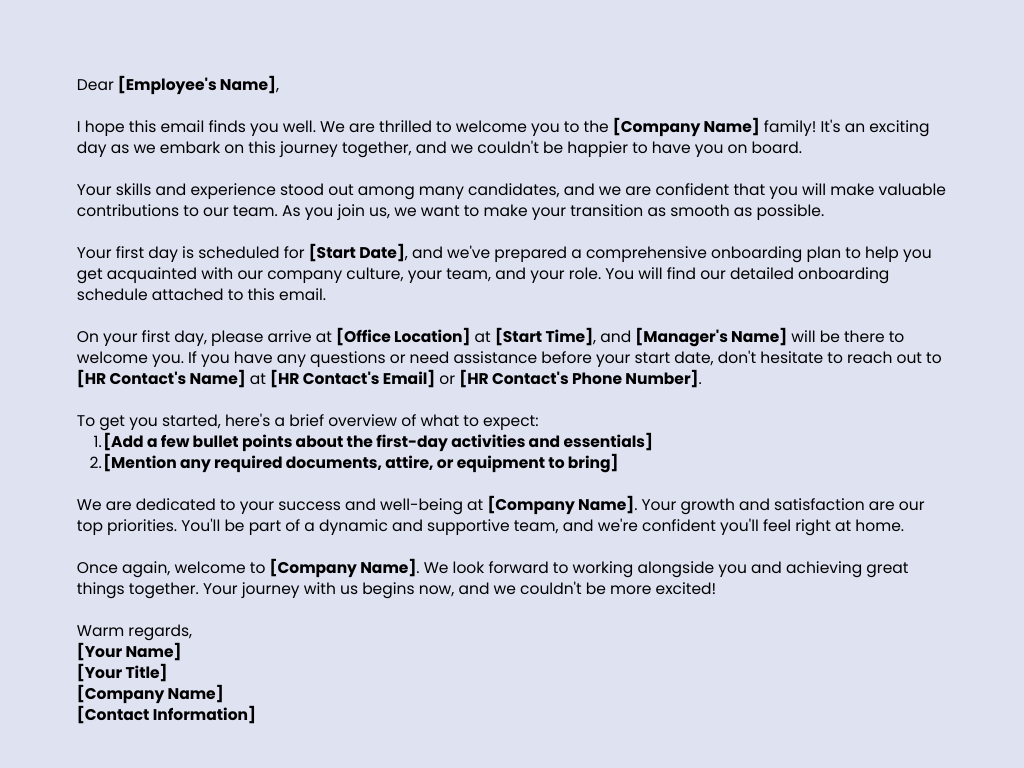What Is Pre-Boarding and Why Should You Have It?
Pre-boarding is an important part of the overall onboarding process for new hires. It refers to the period between when a candidate accepts a job offer and their first day of work.

Pre-boarding sets the right expectations and gets new hires prepared to hit the ground running. Read on to learn more about what pre-boarding is, its benefits, and how to create an effective pre-boarding program.
What is pre-boarding?
Pre-boarding is the time between a candidate accepting a job offer and their start date. A key time to make a good first impression on new employees and help them succeed.
Pre-boarding gives new employees the information, tools, and training they need to start their new job successfully. This is in contrast to onboarding which focuses on their first day, week, and months on the job.
The pre-boarding period can range from a few days to a few weeks depending on factors like:
- The new hire’s notice period at their current job
- How soon you need them to start
- Logistics like relocation
Regardless of the length, pre-boarding is essential for:
- Getting paperwork and compliance items handled
- Sharing important information about the role, team, and company
- Building connections between the new hire and team members
- Reducing first-day stress and information overload
A well-planned pre-boarding program will help new hires feel welcome, prepared, and excited to start their new job.
What is the purpose of pre-boarding?
The main goals and positive impacts of pre-boarding are to:
- Set expectations – Provide details about the job, workplace culture, and more so new hires know what to expect. This reduces surprises and anxiety.
- Build employee engagement – Make new hires feel welcomed and excited to start. This increases retention later on.
- Increase productivity – Allow new hires to hit the ground running by equipping them with what they need to know. This reduces ramp-up time.
- Reduce workload – Complete admin items like paperwork before day one. This leaves more time for meaningful onboarding activities.
- Make a great first impression – Show new hires you are an organised, caring, and communicative company right from the start. This builds trust and loyalty.
With pre-boarding, new employees start feeling informed, connected, and ready to dive into their new role.
What is pre-boarding vs onboarding?
It’s important to understand the difference between pre-boarding and onboarding:
- Pre-boarding occurs between the job offer and the start date. It focuses on logistics, paperwork, introductions, and basic information sharing.
- Onboarding starts on the employee’s first day and continues for months after. It covers deeper training, connection, and skill-building needed to get up to speed.
While they are closely related, preboarding and onboarding play different roles in the new hire experience:
Tips for creating a strong preboarding program
Implementing an employee pre-boarding process as part of your onboarding routine doesn’t need to be overly complicated. Here are some of the following ideas.
Send them a welcome e-mail
When sending a welcome email to new hires, it’s important to make them feel welcome and excited. Here are some tips on how to create a personalised welcome email:
- Use their name: Address the new hire by their name in the email. This will make them feel more connected and valued.
- Express excitement: Let the new hire know that you are excited to have them join your team. This will help create a positive first impression and set the tone for their pre-boarding experience.
- Provide information: Tell new hires what to expect during pre-boarding, like what they will do and who they will meet.
- Ask questions: Ask new hires what they are most looking forward to in their role, and their hobbies and interests. This will help you connect with them and make them feel valued.
- Provide contact information: Provide contact info for their manager or HR department representative in case they have questions or concerns.
Here is an example of a personalised welcome email:

Assign them a buddy
Give each new hire a buddy to help them feel welcome and supported. A buddy is someone who can answer questions, provide guidance, and help them navigate your company culture. This can be especially helpful for new hires who are relocating or starting a new job in a new industry.
Consider someone who has been with your company for at least six months and has experience in their department or role. This person should be easy to approach, friendly, and supportive. They should also be able to guide company culture, policies, and procedures.
Host a virtual meet-and-greet
Virtual meet-and-greets help new hires meet their colleagues before they start working together. You can use Zoom or another video conferencing tool to host the event. Virtual meet-and-greets are especially useful for remote working teams or companies with employees in different locations.
During the meet-and-greet, encourage team members to introduce themselves and share something interesting about themselves. This can help break the ice and create a more relaxed atmosphere. You can also use breakout rooms to facilitate small group conversations. This can help new hires feel more comfortable and engaged during the event.
Here are some tips for hosting a successful virtual meet-and-greet:
- Choose the right platform: Choose a video conferencing platform that is easy to use and accessible to all team members.
- Send out invitations: Send out invitations well in advance of the event so that team members have time to prepare.
- Create an agenda: Create an agenda for the event so that team members know what to expect.
- Encourage participation: Encourage team members to participate in the event by introducing themselves and sharing something interesting about themselves.
- Use breakout rooms: Use breakout rooms to facilitate small group conversations. This can help new hires feel more comfortable and engaged during the event.
- Follow up: Follow up with team members after the event to get feedback and suggestions for future events.
By hosting a virtual meet-and-greet, you can help new hires feel more comfortable and engaged before they start working.
Provide them with swag
New hire swag welcomes new team members and fosters a sense of belonging. Swag includes various branded items, such as t-shirts, water bottles, coffee mugs, and stickers. Choose high-quality, useful swag that new hires will use outside work.
When selecting swag, consider the following:
- Quality: Choose high-quality items that are durable and well-made.
- Usefulness: Choose items that are useful and practical.
- Brand relevance: Choose items that are relevant to your brand and company culture. This will help reinforce your brand identity and create a sense of belonging among new hires.
- Variety: Offer a variety of swag items so that new hires can choose what they like best.
Here are some good ideas for swag items you can provide to new hires:
- Branded t-shirts: Provide new hires with a branded t-shirt that they can wear outside work.
- Water bottles: Provide new hires with a branded water bottle that they can use at home or on the go.
- Coffee mugs: Provide new hires with a branded coffee mug that they can use at home or in the office.
- Stickers: Provide new hires with branded stickers that they can use to decorate their laptop or notebook.
High-quality, useful swag helps new hires feel like part of the team before they start.
Provide them with a welcome kit
Providing new hires with a welcome kit is an excellent way to make them feel like part of the team. A welcome kit can include anything from company swag to a list of local restaurants and attractions. It’s important to personalise the welcome kit to the new hire’s interests and needs. For example, if you know they’re a coffee lover, include a gift card to a local coffee shop.
Here are some items that you can include in your welcome kit:
- Company swag: Provide new hires with branded items such as t-shirts, water bottles, coffee mugs, or stickers.
- Local guide: Provide a list of local restaurants, cafes, and attractions so that new hires can explore their new city.
- Gift card: Provide a gift card to a local coffee shop or restaurant that aligns with the new hire’s interests.
- Employee handbook: Provide a copy of your employee handbook so that new hires can familiarise themselves with your company policies.
- Personalised note: Write a personalised note welcoming the new hire to the team.
Personalised welcome kits make new hires feel like part of the team from day one.
Ask for feedback
Asking new hires for feedback is essential for improving your pre-boarding process over time. Make sure you ask for feedback early and often so that you can make adjustments as needed.
Ask new hires for feedback on the pre-boarding process and what they’d like to see more of from the company. This can help you identify areas where you need to improve and make changes to your pre-boarding process accordingly.

Tools to use for the pre-boarding process
Several tools and platforms can help streamline the pre-boarding process, ensuring both efficiency and effectiveness:
Human Resource Information Systems (HRIS)
- Onboarding Software System centralises employee profiles, documents, and tasks in one secure platform.
- Allows new hires and HR teams to manage pre-boarding tasks and monitor progress with ease.
E-Learning platforms
- Provides online courses and training modules for new hires to complete during the pre-boarding stage.
- Tracks progress and proficiency, ensuring new employees are adequately prepared for their roles.
Collaboration and communication tools
- Facilitates easy communication between new hires, team members, and HR staff through messaging apps, email, or video conferencing platforms.
- Provides a virtual space for new hires to ask questions, receive support, and develop professional relationships.
A good pre-boarding experience helps new hires engage and be more productive from the start, leads to higher retention rates, a more productive workforce, and a positive company culture.
 HR Core
HR Core 









